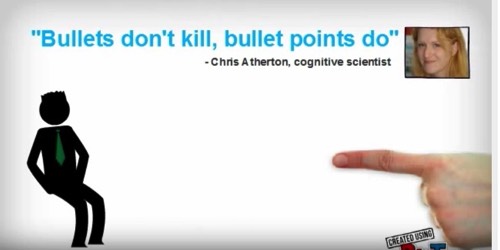Welcome to Presenting the Solution!
Click on the image above to watch a short video on the very real dangers of bullet points!
When presenting a complicated engineering design to a mixed audience, reducing, reducing, and reducing bullets gets the engineer only partway down the road toward a convincing presentation of the solution. It is true that more visuals, less text, and minimal bullets go a long way to making a slide or piece of a presentation engaging and memorable.
But, presentation slides or other aids must also connect together, and have some reason for being that puts them in a much larger context... A STORY.
That is, if you want your audience to remember and understand what you are doing - then tell them A STORY.
The human brain craves a story and a story with a happy ending will leave any audience awake and impressed. As an engineer, it has now become your job to tell the story of your design in such a way that the audience wants this design above all other alternatives. This module in the Basic Engineering Design Suite will take the student through the basics of effective presentations and also the art of telling a story about an engineering design to connect all the pieces of the design and design process together into one coherent, comprehensive, and memorable whole!
Learn more about Presenting the Solution
during the Engineering Design Cycle:
Presentation (.pdf) -- PowerPoint Basics
Presentation (.pdf) -- Telling a Story with PowerPoint
Audio Recording (Youtube) -- PowerPoint Basics
Audio Recording (Youtube) -- Telling a Story with PowerPoint
Assignment in MS Word (.docx) or Portable Document Format (.pdf)
Quiz in MS Word (.docx) or Portable Document Format (.pdf)
Tell a story… that your audience will enjoy!
This suite of educational tools supports the Engineering Design Cycle, from beginning to end, in a way that allows the student to pursue open-ended engineering design from idea to prototype to redesign. These tools can be useful, for both teaching and learning, in a capstone design experience, other design classes, as well as in extracurricular or any other activities that involve formal design.
Explore More:
Overview
Identify the Problem
Research the Need
Design Solutions
Select the Best Solution
Construct a Prototype
Test and Evaluate
Redesign and Iterate
Acknowledgements:
This work was funded in part by the National Science Foundation (DUE-1245464). Any opinions, findings, and conclusions or recommendations expressed in this material are those of the author(s) and do not necessarily reflect the views of the National Science Foundation.
This work was funded in part by the National Science Foundation (DUE-1245464). Any opinions, findings, and conclusions or recommendations expressed in this material are those of the author(s) and do not necessarily reflect the views of the National Science Foundation.


